|
 Al Capone historian David G. Clark has donated a
number of materials to the Mill regarding Route 66. Illinois Route
66 Scenic Byway Project Administrator Geoff Ladd announced that the
Mill has established a Route 66 library and named it the David G.
Clark Library. The new library at the Mill has also earned a spot on
the National Registry of Route 66 Libraries. Al Capone historian David G. Clark has donated a
number of materials to the Mill regarding Route 66. Illinois Route
66 Scenic Byway Project Administrator Geoff Ladd announced that the
Mill has established a Route 66 library and named it the David G.
Clark Library. The new library at the Mill has also earned a spot on
the National Registry of Route 66 Libraries.
The day began inside the Mill with an hour-long presentation by
Clark speaking on the life and times of Al Capone, the connections
to Route 66, as well as Lincoln and Logan County. Then Ladd
led a motor tour around town visiting various Route 66 sites in
Lincoln.
The tour was led in partnership with Sherry Meyer of InSites To Go
Tour Company. The caravan style tour was attended by approximately
15 people. Those going on the tour represented several local folks
as well as some who had signed up for the tour with Myer, and were
from out of town.
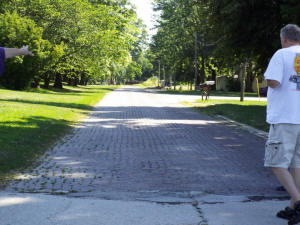
The tour left the Mill at 4 p.m. with the first stop
being at the Cobblestone Avenue. Cobblestone Avenue is a short
stretch of road that runs adjacent to Lincoln Parkway, just one
block north of the Holy Cross and Old Union Cemeteries. As guests
departed their cars and gathered around, Ladd shared that this road,
which is actually brick, is one of the only original Route 66
stretches left in the state.

He said that before there was a Route 66 there was Illinois Route 4.
This stretch of road was constructed pre-Route 66 as Illinois 4.
Ladd said this was a little known Route 66 location, and that there
are no markers in the area to draw attention to the street. He also
explained that at the time the road was constructed it lay in the
city limits of Lincoln and was considered to be city responsibility,
thus the brick.
Further south the group would encounter to road to Ghost Bridge
where Ladd would note that because it was a state maintained highway
it was made of concrete.
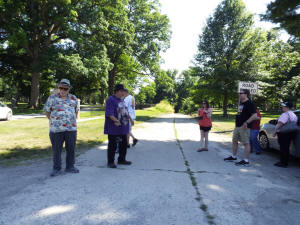
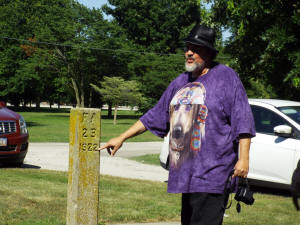
The group’s next stop was the road to Ghost Bridge. Ladd stopped the
group at the top of the hill and noted that the trip down the hill
to the bridge ruins was too dangerous. Ladd explained the clear
differences between the city maintained portions of Route 66 and the
state portions. He noted a special marker at the top of the hill
that designated the stretch of road as a “Federal Aid” road
construction project. Ladd said these particular markers are very
rare. He would like to see the marker protected in some way. He
explained that the road is still used by area farmers, and his
concern is that someday some large piece of equipment may take out
the marker, which would be a great historical loss. The marker is
dated 1922 which offers proof of the age of the old road heading
down to Ghost Bridge.

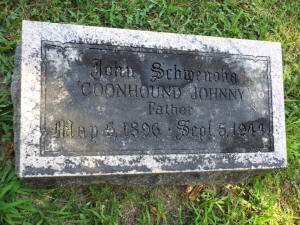
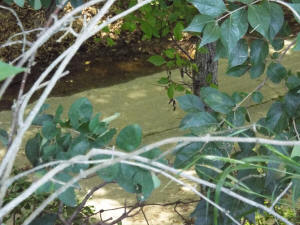
Moving on, the next stop was at the grave of Coonhound Johnny in the
Holy Cross Cemetery. Ladd pointed out the stone to guests and talked
a bit about the local legend. He also noted that Johnny’s grave lies
at the edge of the cemetery and overlooks old Route 66 as the road
makes its steep descent down the hill toward Ghost Bridge.
Ladd spoke about Coonhound Johnny’s legacy in Lincoln as a
bootlegger. He would fill the back of his truck with bootleg liquor
and then put his biggest meanest coon dogs in the back of truck to
protect the hooch. Ladd said that Coonhound Johnny and Al Capone had
a long lasting friendship that exceeded the prohibition era.
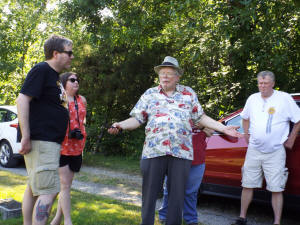
It was also noted by Davis that Johnny was a beloved
member of the community and that he was charitable and civic minded,
making him a stellar member of the community.
The next stop was to the Tropics sign.
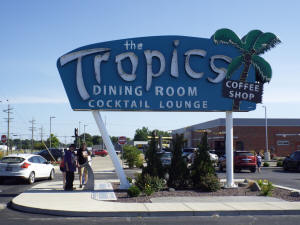
Ladd introduced the Tropics sign to the visitors, telling how the
sign had been saved at the demolition of the Tropics Restaurant. He
said that the Tourism Bureau with a number of partnerships had
restored the sign to its original glory. The sign is placed near its
original position thanks to the Milan Family who own the McDonalds
Franchise in Lincoln. Ladd said that this was an “only in Lincoln”
experience to sit in the drive through at McDonalds and see the
amazing neon sign in its full glory.
Ladd went on to say that some of the original furnishings from the
Tropics are on display at the Mill.
The group then traversed by south on Lincoln Parkway
to the Railsplitter Covered Wagon. At the wagon, Ladd explained that
this location is one that ties the Abraham Lincoln history to the
Route 66 history, though the wagon and the Lincoln statue are not
historically correct.
[to top of second column] |

Ladd said he could believe that Lincoln may have at
some time in his life traveled in a covered wagon, the problem was
that it would have been in his pre-presidential days. The statue
however depicts Lincoln with a beard which we all know Lincoln did
not grow his beard until he was seeking election into the
presidential office.
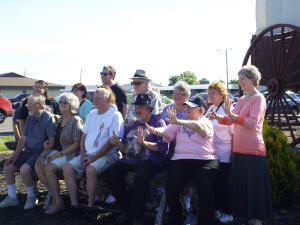
Ladd related the story of how the wagon made its way
to Lincoln and talked about the first and second locations for the
wagon in the city. With the benches that had been donated by the
Logan County Mounted Police sitting in front of the wagon, it was a
great opportunity for a group photo of the tour participants.
From there, because the tour was running behind schedule, Ladd also
talked briefly about Postville Courthouse, a second Route 66 and
Abraham Lincoln combined historic stop.
The group drove Fifth Street to the Postville Courthouse, where they
did a quick drive around the courthouse before moving on to the
Lincoln Christening site on the lawn of the Lincoln Depot/Logan
County Tourism Bureau Office.
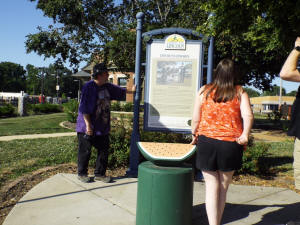
At the christening scene, Ladd explained the event
that occurred in 1853 when the city of Lincoln was actually named
“Lincoln” by then lawyer Abraham Lincoln. The story goes that a
young boy was there selling watermelon out of the back of a wagon.
Abraham Lincoln took a watermelon and squeezed juice into a cup and
then christened the town ‘Lincoln.’
Ladd also explained the railroad connection to the founding of the
city, and Davis noted that in most areas the length of Illinois,
Route 66 traversed adjacent to the railroad.

Ladd also spoke about the various Route 66 routes going through
Lincoln, noting that the first Route 66 alignment came into the
heart of town on Kickapoo Street and turned west on Broadway Street,
going right past the depot.
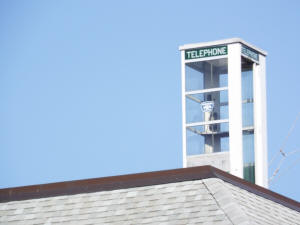
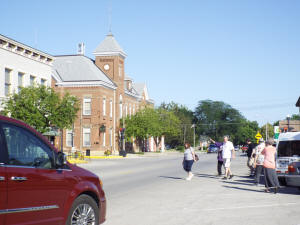
With time running out and dinner waiting at Sorrento’s, Ladd took
the group into the heart of town. Outside, he pointed out the
infamous phone booth on top of city hall. He noted the story goes
that the phone both was originally placed on the roof as an air-raid
spotter location during World War II, but was more commonly used as
a weather spotter location.
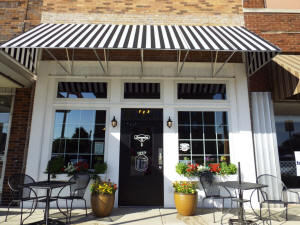
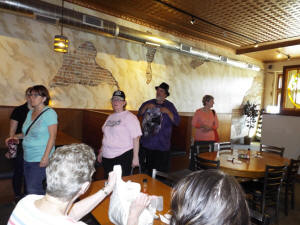
Guests then made their way into Sorrento’s Pizzeria where they
enjoyed the ‘Al Capone Smokin’ Cannoli Special’ consisting of a
medium pizza, four Capone Cigar’s (soft pretzel sticks) and two
cannolis.
While there they heard from Lisa Drew about the 50-year-history of
the eatery. She explained that her husband’s family had traveled
Route 66 looking for their home as Italian immigrants. They had come
to Lincoln and settled in for the long haul. Lisa Drew herself is a
native of the area and grew up in Havana. She recounted a story her
grandfather often told.
When Drew’s grandfather was a youngster riding with his father,
their vehicle broke down along the side of the road in the Havana
area. Another car stopped and a number of people helped get the
vehicle going again. Drew said that when the car was going there was
a little bit of scuttle, and a voice inside the other car told the
helpers, “Leave them alone, they are just poor working people.” The
helpers then got in the other car with the voice and drove away.

Drew said her grandfather asked his father who those people were,
and the grandfather announced that it had been Al Capone and his
gang. Drew said she had nothing to prove that was correct, but that
it was the story her grandfather told to his dying day.
Clark said that while not proven, it was perfectly possible, as
Capone and his gang had been known to visit Mason County and the
Havana area.
After that, the guests settled in to ordering and enjoying their
meal. They were encouraged to stay as long as they wished as this
was the ending point of the tour and the balance of the evening was
theirs to explore more of the town, or head on home.
It was noted that some were going to stay the night in local motels,
including Davis and Myer who planned on doing some more exploring
around the area on Sunday as they work to develop multiple tours
into Logan County.
All in all, it was a very successful day for the Mill and the tour.
Attendees were invited, but not required to make donations to the
Mill while at the lecture. In addition, while ordering off the menu
was okay, all the Al Capone specials ordered resulted in a donation
to the Mill from Sorrento’s.
The Mill is privately owned by the Route 66 Heritage Foundation and
is not supported by any state or federal grants. The Logan County
Tourism Bureau did contribute to the Mill in 2018 through its
preservation grant program.
[Nila Smith] |